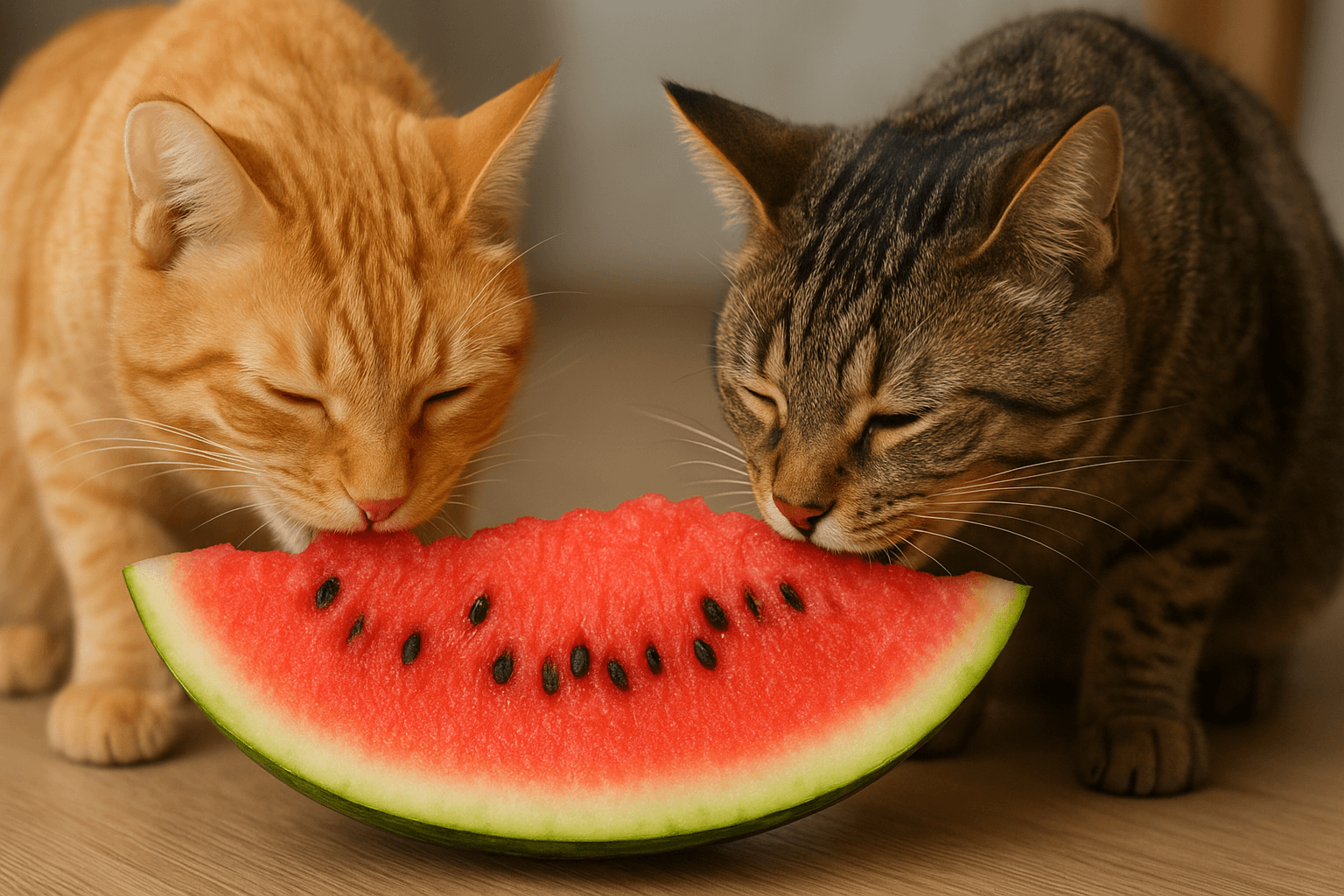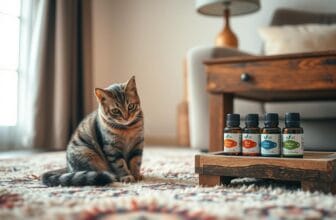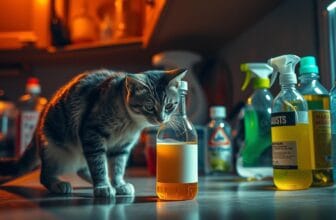
Table of Contents
Did you know cleaning supplies under your sink can be a danger to your cat? Every year, many cats get hurt by chemicals, making simple tasks risky.
It’s crucial to have cat-proof cleaning supplies if you own a pet. Cats’ curiosity can lead to danger with toxic cleaners. This guide will show you how to keep your home safe for your cat.
Keeping your home pet-safe doesn’t mean you can’t clean. It’s about finding safe ways to keep your home clean. You’ll learn how to reduce risks and keep your cat safe.
By the end of this article, you’ll know how to make your home safe for your cat. You’ll learn how to keep cleaning supplies and pet safety in balance.
Understanding the Risks of Household Cleaning Products to Cats
Your cat’s curious nature can be a big risk with toxic cleaning products. Cats are small and their metabolism is different from humans. They can’t break down toxic substances as well, making them very sensitive.
- Direct contact with cleaning surfaces
- Licking contaminated paws
- Inhaling chemical vapors
- Walking on recently cleaned floors
Common Toxic Ingredients in Cleaning Supplies
Many cleaning products are dangerous for cats. The most common harmful ingredients include:
| Chemical | Potential Risks | Found In |
|---|---|---|
| Ammonia | Respiratory damage | Glass cleaners, all-purpose cleaners |
| Chlorine | Lung irritation, chemical burns | Bleach, toilet cleaners |
| Phenols | Liver and kidney damage | Disinfectant sprays, some floor cleaners |
Signs of Chemical Poisoning in Cats
Knowing the signs of chemical poisoning is key. Look out for these symptoms:
- Excessive drooling
- Difficulty breathing
- Vomiting or diarrhea
- Lethargy or weakness
- Tremors or seizures
Emergency Response Guidelines
If you think your cat has been poisoned, act fast. Always contact your vet or a pet poison control center right away. Keep their numbers handy at home.
Essential Storage Solutions for Cat-Safe Homes
Keeping your cats safe from cleaning supplies is crucial. Cat-proof storage solutions are a must for pet owners. If you don’t take the right steps, curious cats can get into harmful chemicals.
There are several ways to make your home safe for cleaning supplies. The layout and space in your home will help decide the best storage plan. Here are some important steps to keep your cleaning products out of reach:
- Install high-mounted cabinets with secure latches
- Use childproof locks on lower storage areas
- Select cabinets with tight-sealing doors
- Store chemicals in locked containers
Every room needs its own storage plan. Kitchen and bathroom areas are especially risky for chemical exposure. Get storage solutions that keep cats away from dangerous items:
- Overhead cabinets with magnetic locks
- Locked storage bins with tight-fitting lids
- Dedicated cleaning supply closets
- Elevated shelving units out of cat’s reach
Prevention is always better than treating an emergency. By using cat-proof storage, you protect your pets from poisoning. This also gives you peace of mind.
Secure Cabinet Organization Systems
Keeping your cat safe from cleaning supplies is key. Pet-safe cabinet organization is more than just storing things. It’s about making a safety zone that keeps cats away from harmful chemicals.
Childproof cabinet locks are your first defense against pet accidents. These locks act as a barrier between your cleaning supplies and your curious cat.
Choosing the Right Childproof Cabinet Locks
When picking childproof cabinet locks, look for these features:
- Strong adhesive for secure installation
- Durable plastic or metal
- Resistant to cat’s paws
- Easy for humans to use
High Storage Solutions
Elevating storage can help keep pets safe. Here are some ideas:
- Install cabinets out of your cat’s reach
- Use wall-mounted storage
- Lock overhead compartments
Proper Container Sealing Methods
“A sealed container is a safe container” – Pet Safety Experts
Sealing containers is also crucial. Make sure all cleaning supply containers have tight lids. These should resist curious paws and spills.
By using childproof locks and smart organization, you can make a safe space. This protects your cleaning supplies and your cat.
Cat Proof Cleaning Supplies: Best Practices
Keeping your cat safe while cleaning is very important. You need to be careful with household chemicals. This helps keep your cat healthy.
Start by understanding what makes your cat vulnerable. Cats are small and can easily get hurt by chemicals. So, you must do your research and choose safe products.
- Always dilute cleaning products according to manufacturer instructions
- Use pet-safe, non-toxic cleaning solutions whenever possible
- Keep cats away from freshly cleaned areas until surfaces are completely dry
- Ventilate rooms during and after cleaning to reduce chemical vapor exposure
When picking cleaning supplies, choose products that are safe for pets. Look for certifications that indicate low toxicity and minimal risk to animals. Instead of harsh chemicals, try using natural stuff like vinegar and baking soda.
Be careful how you use cleaning products. Spray them on cloths first, not directly on surfaces. This helps prevent harmful chemicals from getting in the air and hurting your cat’s lungs.
“A clean home doesn’t have to compromise your cat’s safety” – Veterinary Safety Experts
Prevention is key. By following these safe cleaning tips, you make a better home for you and your cat.
Natural and Pet-Safe Cleaning Alternatives
Keeping your home clean doesn’t have to harm your pets. Homemade cat-safe cleaners are a great choice. They make your home shine while keeping your cats safe.
Making your own cleaning solutions is simple. You can use common kitchen items to create strong cleaners. These are safe for your pets.
DIY Pet-Friendly Cleaning Solutions
Your kitchen has everything you need for safe cleaners. Here are some easy recipes:
- All-Purpose Cleaner: Mix equal parts white vinegar and water
- Glass Cleaner: Combine water, white vinegar, and a drop of liquid soap
- Floor Cleaner: Use warm water with a splash of white vinegar
These homemade cleaners are effective and safe for your home.
Recommended Commercial Pet-Safe Products
Some people like ready-made cleaners. We’ve found some top natural options:
| Brand | Product Type | Pet Safety Rating |
|---|---|---|
| Seventh Generation | All-Purpose Cleaner | Excellent |
| Method | Multi-Surface Cleaner | Very Good |
| Nature’s Miracle | Pet-Specific Cleaning | Superior |
“The best cleaning solution is one that protects both your home and your pets.” – Veterinary Safety Association
Always ventilate well and keep pets away from wet areas. Make sure surfaces are dry before letting them back.
Laundry Room Safety Measures

Creating a cat-safe laundry room needs careful planning. Your feline friend can face dangers in this space. It’s important to pet-proof washers and dryers for their safety.
Cats are curious and love warm, enclosed spaces. Your laundry room has many hazards. You must manage them proactively.
- Always keep washer and dryer doors closed when not in use
- Check inside appliances before starting a cycle
- Store detergents in sealed, high cabinets
- Use childproof locks on storage areas
A cat-safe laundry room needs smart organization and constant watch. Keep cleaning products away from your cat. Also, secure appliance entry points.
| Potential Hazard | Prevention Strategy |
|---|---|
| Open Washer/Dryer | Always close doors immediately |
| Loose Detergents | Store in locked, elevated cabinets |
| Lint and Small Objects | Clean immediately, store away from cat’s reach |
By following these steps, you can protect your curious cat from accidents in the laundry room.
Kitchen Cleaning Supply Management
Keeping your curious cat safe from cleaning supplies starts with organizing your kitchen. The area under your kitchen sink is key for under-sink storage and keeping cabinets safe.
Cats love to explore and can fit into small spaces. This makes your kitchen storage areas risky. A good safety plan can stop them from getting into harmful chemicals.
Under-Sink Organization Strategies
Effective under-sink storage needs several layers of safety:
- Install childproof cabinet locks to stop curious paws from opening doors
- Use clear, sealed plastic containers with tight-fitting lids
- Organize cleaning supplies by how often you use them
- Keep toxic chemicals in places that are hard for cats to reach
Counter-Top Safety Protocols
Your kitchen counters also need safety checks. Always put away cleaning products right after use. Never leave chemical containers out when your cat is around.
Here are more safety tips:
- Make a special storage spot away from where you cook
- Use high shelves or locked cabinets
- Check storage containers often for leaks or damage
Prevention is key when keeping your cat safe from harmful chemicals.
Bathroom Chemical Safety Guidelines
Bathrooms can be tricky for cat owners when it comes to keeping things safe. Cats are curious and might get into cleaning products. To keep your pet safe, you need to plan and manage cleaning products carefully.
It’s important to know the dangers of bathroom cleaners. Cats can get into trouble by licking surfaces, walking through cleaned areas, jumping on counters, or knocking over chemicals.
To keep your cat safe, follow these tips:
- Lock up all cleaning products
- Choose pet-friendly cleaners with natural ingredients
- Make sure to rinse surfaces well after cleaning
- Keep cats out of the bathroom while you clean
| Cleaning Product Type | Potential Cat Risk | Safe Alternative |
|---|---|---|
| Bleach-based Cleaners | High Toxicity | Vinegar-based Solutions |
| Chemical Toilet Cleaners | Severe Poisoning Risk | Enzymatic Pet-Safe Cleaners |
| Disinfectant Sprays | Respiratory Irritation | Natural Hydrogen Peroxide Cleaners |
Always prioritize your cat’s safety when selecting and using bathroom cleaning products.
Proper Ventilation During Cleaning
Keeping your cat safe while cleaning means watching the air quality closely. Chemical smells from cleaners can harm your cat’s breathing. It’s important to have good air flow to keep your home healthy.

When you clean your house, making sure the air moves well is key. Reducing harmful smells is easy with a few steps. These steps help keep you and your cat safe.
Air Quality Considerations
Focus on air quality with these steps:
- Open windows and doors during and after cleaning
- Use fans to circulate fresh air
- Remove cats from the cleaning area
- Choose cleaning times with optimal outdoor ventilation
Safe Cleaning Schedules
Plan your cleaning to avoid exposing your cat to harmful chemicals:
- Clean when cats are in a separate, well-ventilated room
- Allow at least 30 minutes of air circulation after cleaning
- Use pet-safe, low-chemical cleaning products
- Clean during times when windows can remain open
Proper ventilation is your first line of defense against potential chemical hazards in your home.
Using these ventilation tips makes cleaning safer for your cat. It keeps your home clean and healthy without risking your cat’s health.
Emergency Response Kit Preparation
Creating a pet poison first aid kit is key for cat owners. It’s vital for handling sudden chemical exposure. Being ready ahead of time means you can act fast and right.
A good cat emergency kit has several important items:
- Activated charcoal (veterinarian-approved)
- Saline solution for eye and wound cleaning
- Digital thermometer
- Disposable gloves
- Hydrogen peroxide (3%)
- Pet-safe antiseptic wipes
- Emergency contact information for your veterinarian
Where you put your first aid kit is important. Place it where you can get to it fast but not where it’s dangerous. Make sure it’s in a waterproof bag and check the dates every six months.
Being ready isn’t just about the kit. Learn basic first aid for pets and have your vet’s number ready. Taking a pet first aid course can also help you feel more confident.
“Preparation is the key to managing unexpected pet health emergencies.” – Veterinary Emergency Specialists
Make your first aid kit fit your home and cat’s needs. Keep it updated and know how to use each item.
Training Family Members on Safety Protocols
Keeping your cat safe from household chemicals is a team effort. Family pet safety rules are key to a safe space for your cat. This ensures they stay away from dangers.
Start by talking clearly and teaching everyone about safety. Working together can stop accidents and keep your cat healthy.
Creating Comprehensive Safety Rules
Make simple, clear rules for everyone in the house:
- Always close and secure cleaning supply cabinets immediately after use
- Never leave chemical products unattended
- Store toxic substances in high, locked cabinets away from cat’s reach
- Clean up spills instantly
- Use child-proof locks on storage areas
Emergency Contact Information
Have a list of emergency contacts ready:
- Local veterinary clinic phone number
- Pet poison control hotline
- Your family veterinarian’s contact details
- Nearest 24-hour emergency animal hospital
Pro tip: Put this list on the fridge or somewhere everyone can see it. It’s important for quick access in emergencies.
Hold regular family meetings to review safety rules. This keeps everyone focused on protecting your cat.
Safe Disposal of Cleaning Products
It’s important to dispose of cleaning products in an eco-friendly way. This keeps your environment and cat safe. Knowing how to manage chemical waste is key to avoiding dangers and protecting our planet.

When getting rid of cleaning supplies, you need to follow certain rules. Each product has its own way of being disposed of, based on its chemicals.
- Liquid cleaners should never be poured down drains or toilets
- Solid chemical products need careful packaging before disposal
- Check local waste management regulations for specific instructions
Your local waste management center can help with hazardous chemical disposal. Many places have free collection events for eco-friendly cleaner disposal all year.
| Product Type | Disposal Method | Safety Precautions |
|---|---|---|
| Spray Cleaners | Recycling Center | Empty completely, remove labels |
| Toxic Chemicals | Hazardous Waste Facility | Keep in original containers |
| Mild Detergents | Regular Trash | Seal container tightly |
Managing chemical waste safely takes some planning. Always wear gloves when handling containers. Keep them away from pets and kids while disposing.
Remember: Your responsible disposal protects both the environment and your furry friends.
Monitoring Your Cat’s Behavior Around Supplies
Watching your cat’s behavior is key to keeping them safe from cleaning supplies. Cats are naturally curious, which can put them in danger. So, it’s important to keep a close eye on them to avoid poisoning.
Knowing when your cat acts differently can help you spot danger signs fast. Look out for these signs:
- Excessive drooling or pawing at the mouth
- Sudden lethargy or weakness
- Unusual vocalization or distress
- Changes in eating or drinking habits
- Unexplained vomiting or diarrhea
It’s also important to watch how your cat interacts with cleaning areas. Cats might be drawn to these areas because of the smells or leftover chemicals. These can be very harmful to their health.
| Behavioral Indicator | Potential Risk Level | Recommended Action |
|---|---|---|
| Licking cleaned surfaces | High | Immediate intervention required |
| Rubbing against recently cleaned areas | Medium | Wash cat’s fur, check for chemical residue |
| Sniffing cleaning products | Low | Remove cat from area, secure products |
Proactive prevention is the best way to keep your cat safe from chemicals. Make sure to have a special area for cleaning and keep products out of your cat’s reach. Always put them away after you’re done using them.
Regular Safety Audits and Maintenance
Keeping your cat safe needs ongoing effort and smart home safety checks. Regular inspections are key to a safe space for your curious cat. A systematic safety plan helps avoid dangers before they happen.
Having a detailed monthly safety check keeps you one step ahead. Your home safety check should look at places where dangers might hide.
Monthly Safety Checklist Essentials
- Inspect all cabinet locks and latches for proper functionality
- Review storage locations of cleaning chemicals
- Check for any new potential hazards introduced since last inspection
- Evaluate current cleaning product inventory
- Ensure proper container sealing
Updating Safety Measures
More than just a quick look is needed for cat-proofing. Detailed documentation of your safety audit helps track improvements and spot recurring problems.
- Document any new potential risks
- Update safety protocols as needed
- Replace worn-out safety equipment
- Retrain family members on current safety guidelines
By making home safety a regular part of your routine, you protect your cat. These checks turn prevention into a way of life. This keeps your cat safe and happy.
Preventive Measures and Daily Routines
To keep your cat safe, you need to follow daily safety habits and routine cat-proofing. Simple safety checks each day can greatly reduce risks. This helps protect your cat.
Begin with a daily safety routine that feels natural. These steps don’t have to be hard or take a lot of time. A few key checks can keep your home safe for your cat.
- Do a quick morning check for hazards in your home
- Make sure cleaning supplies are locked away
- Keep toxic items out of your cat’s reach
- Check windows and doors for escape risks
Your daily routine should include proactive observation. Watch how your cat moves around the house. Look for new dangers that might have appeared. Cats are curious and can get into trouble.
Have a plan for daily cat-proofing. Choose specific times for safety checks, like during morning coffee or evening cleaning. Get everyone in your family involved to make your home safe for your cat.
- Keep a safety checklist in busy areas
- Share safety duties among family members
- Change safety rules as your cat grows or your home changes
By making safety a part of your daily life, you’ll create a safe and loving home for your cat.
Conclusion
Keeping your home safe for cats is not just a one-time task. It’s a continuous effort to protect your pet from dangers in cleaning supplies. You need to regularly check, plan ahead, and keep your home clean and safe for your cat.
Every room in your house has its own dangers, from the kitchen to the laundry area. By using the tips from this guide, you can keep your cat safe from harmful chemicals. Always remember, it’s better to prevent harm than to cure it when it comes to your cat’s safety.
Keeping your home safe for pets takes constant attention, learning, and practice. Begin by checking your cleaning habits, buying safe products, and finding ways to keep dangerous items away from your cat. Your hard work will make your home a safer, happier place for your pet.
Protecting your cat from dangers in cleaning supplies is a never-ending job that needs your focus and care. By staying informed, flexible, and proactive, you can make a safe space for your cat to thrive.
FAQ
How toxic are common household cleaning supplies to cats?
Many household cleaning supplies are very toxic to cats. They can cause serious health problems like breathing issues, skin irritation, and damage to organs. Bleach, ammonia, phenols, and glycol ethers are especially dangerous. If cats get into these, it can lead to poisoning.
What are the most important steps to protect my cat from cleaning supplies?
To keep your cat safe, store cleaning supplies in locked cabinets. Use childproof locks and keep them out of reach. Always close cabinet doors and make sure the area is well-ventilated. Also, use natural, pet-safe cleaning products when you can.
How can I recognize if my cat has been exposed to cleaning chemicals?
Watch for signs like a lot of drooling, vomiting, trouble breathing, and feeling very tired. Look for burns on their mouth or paws, changes in behavior, and skin irritation. If you think they’ve been exposed, call your vet right away and have the product info ready.
Are there pet-safe cleaning alternatives I can use?
Yes, you can make your own cleaning solutions with safe stuff like white vinegar, baking soda, and hydrogen peroxide. There are also pet-friendly cleaning products available that are safe for animals.
How often should I check and update my cleaning supply safety measures?
Check your cleaning supply storage and use every month. Make sure cabinet locks are working, review where products are stored, and look for hazards. Also, make sure everyone in your household knows the safety rules.
What should I include in an emergency chemical exposure kit for my cat?
Your kit should have vet contact info, pet-safe activated charcoal, saline solution, non-stick gauze, clean towels, gloves, and the poison control hotline number. Keep it where you can get to it fast and make sure everyone knows where it is.
How can I safely dispose of cleaning product containers?
Rinse containers well, check if they can be recycled, and keep them sealed. Dispose of them in outdoor trash bins that pets can’t get into. Never leave empty containers where cats might find them.
What areas of my home are most dangerous for cleaning supply storage?
The most dangerous spots are under kitchen and bathroom sinks, laundry rooms, and low places where cats can get to chemicals. These areas need the most safety measures and watching.
Can chemical fumes from cleaning supplies harm my cat?
Yes, chemical fumes can hurt your cat’s breathing, eyes, and might cause long-term health problems. Always open windows, use fans, and keep cats away from the cleaning area to avoid this.
What should I do if I suspect my cat has been poisoned by cleaning supplies?
Call your vet or the ASPCA Animal Poison Control Center right away. Don’t make your cat vomit unless a vet tells you to. Bring the product container and get your cat to a vet clinic fast.







